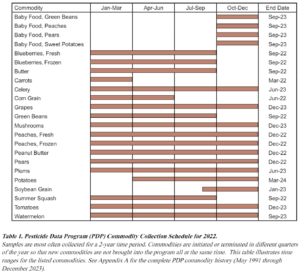Does my produce have pesticide residues?
The Dirt
The USDA’s annual Pesticide Data Program was recently released. And with that comes sensational reports by agencies that create fear of fresh produce…the exact foods we all need to eat now more than ever. How can we put aside misguided information to help promote pesticide-conscious practices while enjoying the undisputed necessity of fruits and vegetables in our daily lives?
Global Food
Does my produce have pesticide residues?
The Dirt
The USDA’s annual Pesticide Data Program was recently released. And with that comes sensational reports by agencies that create fear of fresh produce…the exact foods we all need to eat now more than ever. How can we put aside misguided information to help promote pesticide-conscious practices while enjoying the undisputed necessity of fruits and vegetables in our daily lives?
In the realm of healthy eating, fruits and vegetables reign supreme. However, alongside their abundant vitamins, minerals, and other micronutrients, we’re bombarded with a reminder of a less savory and potentially harmful aspect: the presence of pesticide residues on our produce.
A Brief History of Pesticides & the EPA
But first, let’s get one thing straight: pesticides have a very necessary place in our global food system. Without products like insecticides, fungicides and other pesticide types, all crops would be prone to rot, leading to famine, disease, global hunger…just to name a few. If we suddenly nixed all pesticides, our current situation with egregious food waste in this country would seem inconsequential.
However, too much of a seemingly good thing always has unintended consequences. In the 1940s, the advent of powerful broad-spectrum pesticides, like DDT, gave farmers an effective, long-lasting tool to protect their animals and crops from insects. Furthermore, these powerful tools also helped combat malaria, typhus, and other insect-born human diseases.
But then its surge in application came at a cost.
By the ‘60s, word got out that excessive use of DDT posed unacceptable acute and long-term health risks to humans, including seizures, birth defects, and cancer, as well as damaging wildlife and the environment. In response to the outcry, the U.S. government took swift action and created the Environmental Protection Agency (EPA) to protect human health and the environment from toxic chemicals, including now-prohibited pesticides like DDT, aldrin, and hexachlorobenzene (HCB).
Pesticide Reporting
Now, in conjunction with the USDA, various crops are monitored annually for pesticide residues with the annual Pesticide Data Program (PDP).
 This year’s report is based on data from the 2022/23 season and includes multiple samples from over 20 fresh crops, like green beans, potatoes, and blueberries. Popular crops not tested this particular season, like apples, oranges, and avocadoes, will be included in the next rotation of tested crops.
This year’s report is based on data from the 2022/23 season and includes multiple samples from over 20 fresh crops, like green beans, potatoes, and blueberries. Popular crops not tested this particular season, like apples, oranges, and avocadoes, will be included in the next rotation of tested crops.
The USDA then reports its findings in a comprehensive summary released on the PDP website. Once released to the public, consumer information agencies like Consumer Reports and the Environmental Working Group reinterpret the USDA’s findings to create these derivative reports, like the notorious “Dirty Dozen” list.
When you use the massive PDP database to start weaving information together across various crops over a multitude of years, you often find a conflicting story. Suddenly, these reports stating that you’re ingesting endocrine-disrupting and cancer-causing nerve agents feel sensational, at best, against the opposing PDP data that show a downward trend year-over-year in highly toxic pesticides.
Non-governmental or non-academic, consumer-centric reports can generate fear and deceive us into believing that ingesting any fresh fruit or vegetable is detrimental to our overall health, or that organic produce is free from all pesticides.
Despite the many claims in these consumer reports, available evidence suggests that the low levels of pesticide residues typically found on produce are unlikely to make most people sick or cause cancer.
Focusing on Facts
With that stated, we can’t ignore some of the pesticide residue data these reports found. Specifically, reports from the PDP and Consumer Reports shared the below facts based on information from the PDP database when the USDA’s initiative began in 1994:
The good news:
- 99% of the samples tested in this year’s report had residues below the EPA’s legal limits (or “tolerances”)
- 28% didn’t have any detectible pesticide residues
- Despite growing fears about the long-term effects of Roundup, or glyphosate, the controversial herbicide was only detected on crops largely intended for animal feed – soybean grain and corn grain
- The World Health Organization (WHO), and its Joint Meeting on Pesticide Residues (JMPR) committee, have found that pesticide residues in food are unlikely to cause cancer in people through dietary exposure:
“JMPR’s risk assessment found that based on the weight-of-evidence approach, these compounds are unlikely to cause cancer in people via dietary exposure. This means it is possible to establish safe exposure levels – acceptable daily intakes (ADI) – for consumers.”
The bad news:
- Green beans had numerous residues exceeding current tolerance levels
- The USDA found 16 unique pesticides on these samples, some of which the EPA canceled use or banned over a decade ago, like methamidophos
- Of all produce exceeding EPA tolerances, 66% were from imported crops
- Crop samples from Mexico reported the highest residue levels, including green bean samples with multiple residues exceeding EPA tolerances
- Largely imported crops include blueberries, grapes, tomatoes and watermelon (rind removed).
An Optimistic Outlook
Though some of these findings sound concerning, we found plenty of information that shows the needle moving in the right direction.
Here are some of the highlights we found in these reports over the last few years, plus some information gathered from conducting our own research in the PDP database and other farming resources:
Lower toxicity
- D2D analysis shows top residues found across most fresh produce crops are less toxic than previously reported years, as indicated by WHO‘s pesticide toxicity classifications
- Lesser toxic fungicides include boscalid, azoxystrobin, and fluopyram; insecticides bifenthrin and imidacloprid
Increased localization
- The USDA’s most considerable residue risks stem from just a few pesticides concentrated in specific foods grown on a small fraction of U.S. farmland
- CR’s food safety expert, James E. Rogers, emphasizes that this concentrated risk makes it easier to identify problems and develop targeted solutions.
Better technology
- Farmers and food producers continue to implement improved pest management practices, including advanced technologies
- Precision ag systems in the field
- AgZen’s patented pesticide droplet optimizer
- FruitScout’s crop load manager platform
- John Deere’s comprehensive machinery and production management tools
- Scientific applications for crop management
- Organism-derived biopesticides, like biocontrol technology and research company, Bionema
- Genetically modified plant-incorporated protectants, like Monsanto’s Bt corn (now owned by Bayer)
- Insect growth regulators that inhibit a pest’s life cycle
- Precision ag systems in the field
What can we do right now?
It’s more like what you can’t do.
It feels counterintuitive, but don’t eat fewer fruits and vegetables because of pesticide concerns. The health benefits of eating lots of produce far outweigh the potential risks from these residues.
There’s no doubt about it: produce is loaded with vitamins, minerals, and micronutrients necessary for a healthy body and well-functioning brain.
If anything, we all should eat more produce.
And yes, while some pesticides can negatively affect health and the environment, the levels found on most produce are extremely low and not linked to adverse health effects.
If we follow the food-prep tips below, the surface residues will be largely eliminated, allowing us to enjoy our fresh foods without fear.
- Wash fruits and veggies under running water for 15 to 20 seconds.
- For those especially concerned about residues, consider one of the following methods:
- Soak your fresh produce in a bath for a few minutes with 5 parts water and 1 part vinegar, then rinse; or
- Soak your produce in a solution of one teaspoon of baking soda per two cups of cold water for 10-15 minutes, then rinse
- For those especially concerned about residues, consider one of the following methods:
- Peel and trim produce when possible
- Eat a variety of produce from different sources to reduce exposure to a single pesticide or environmental contaminant
- If you can only tolerate certain produce items, consider purchasing the following alternatives:
- Selecting the organic counterpart, which the PDP reports to have fewer residues despite having the same nutrient density as conventional
- Frozen produce has already been through rigorous cleaning and processing, further reducing residues than its fresh counterparts
- If you can only tolerate certain produce items, consider purchasing the following alternatives:
- Try to stick with produce farmed in the U.S.
The key is moderation and making informed choices, not eliminating nutrient-rich produce from your diet due to pesticide fears.
The Bottom Line
While pesticide residues remain a concern, knowledge and informed decisions empower us to navigate the complex food safety landscape. Let’s savor the bounty of fruits and vegetables while advocating for a healthier, pesticide-conscious future.

Does my produce have pesticide residues?
Sensational reports on pesticides create fear of fresh produce…the exact foods we all need to eat now more than ever. How can we put aside this misinformation to help promote pesticide-conscious practices while enjoying the undisputed necessity of fresh produce in our diets?

Uncovering Illegal Fishing Boats
A recent study reports that 75% of all global fishing fleets are considered “dark vessels” – untraceable ships illegally capturing seafood while damaging biodiversity, local economies, and quality of life for millions. So we asked ourselves: do we know where our seafood comes from?







